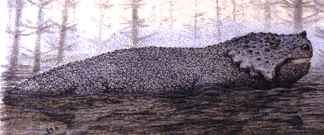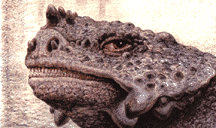
Scutosaurus
karpinskii (Amalitzky, 1922) skeleton of immature specimen
Parareptilia:
Pareiasaurida: Pareiasaurina: Pareiasauridae
Locality: Sokolki,
Malaya Severnaya Dvina River,
Arkhangelsk Region, northern European Russia
Age:
Late Permian, 250 million years ago
Scutosaurus
karpinskii (Amalitzky, 1922) skeleton of mature specimen
Parareptilia:
Pareiasaurida: Pareiasaurina: Pareiasauridae
Locality: Sokolki,
Malaya Severnaya Dvina River,
Arkhangelsk Region, northern European Russia
Age:
Late Permian, 250 million years ago
At
the end of the Late Permian what it was now East Europe
was infused by newcomers
from the south.
The fauna of East Europe and Gondwana became very similar in their
components.
The climate became hotter and dryer,
resulting in the disappearance
of the extensive brackish lakes. 
One
of the most characteristic land tetrapods of that time was the huge parareptile
Scutosaurus of the family Pareiasauridae. These animals dwelt in numbers in small
fresh-water
basins, feeding on floating vegetation. Their flat teeth with serrated edges
were
adapted to filter the water when feeding. The thick leather in Scutosaurus, like
in
amphibians, had numerous glands.





